:::::::::::::::::::::::::::::::::::::::::::::::::::::::::::::::::::::::::::::::::::::::::::::::::::::
Insects (mushi)
***** Location: Japan, worldwide
***** Season: All Autumn, see below
***** Category: Animals
*****************************
Explanation
Before we start with this kigo, did you know that the biggest insect of them all is the "naked insect" hadakamushi 裸虫, the human being !
裸虫さし出て時雨時雨けり
hadaka mushi sashidete shigure shigure keri
a wiggling worm
peeks out...winter rain!
winter rain!
Kobayashi Issa
Hadaka mushi, literally "naked bug," refers to a critter that lacks wings or legs: a worm, a slug, or the like. Metaphorically, it can also refer to a poor person without clothes; Kogo dai jiten (Shogakukan 1983) 1325.
Tr. David Lanoue
:::::::::::::::::::::::::::::::::::::::::::::::::::::::::::::::::::::::::::::::::::::::::::::::::::::
Insects in this context are the ones that make a lot of noise in autumn, like crickets and cicadas. This kigo is usually used in the plural meaning.
insects, mushi 虫
autumn of the insects, mushi no aki 虫の秋
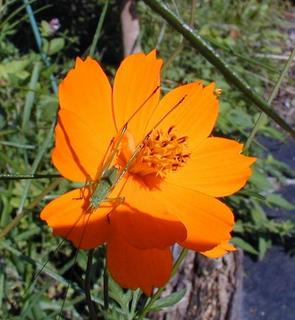
lit: "voice of the insect", chirping insects,
mushi no ne 虫の音
..... mushi no koe, 虫の声
shrill chorus of insects, mushi shigure 虫時雨
..... Lit. Snow shower of insects (voices)
insects at daytime, hiru no mushi 昼の虫
left-over insects (from early autumn) , nokoru mushi 残る虫
clinging insects, sugaru mushi すがる虫
box for keeping insects, mushikago, mushiko 虫籠
dealer for insects, mushiya 虫家, mushi-uri 虫売り
.. knowledgeable about insects, mushi-kiki 虫聞き

. . . CLICK here for Photos !
mushikiki at Dokanyama, Edo 道灌山 道灌やま虫聞
Sanjūrokkyō Dōkan-yama Mushi-kiki Utagawa Toyokuni III
A Dealer of Insect Baskets of Old Edo
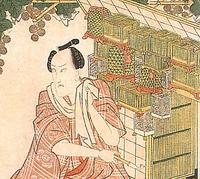
http://www.surugaya.com/kodawari/mushiyomo/
. mushikago - cages for insects - introduction .
observance kigo for all autumn
hunting for insects, mushikari 虫狩 (むしがり)
..... mushi tori, mushitori 虫採り(むしとり)
selecting insects, mushi erabi 虫選び (むしえらび )
..... mushi fuku 虫吹く(むしふく)
pairing insects, mushi awase 虫合わせ (むしあわせ)
"Poetry competition of the Insects"
:::::::::::::::::::::::::::::::::::::::::::::::::::::::::::::::::::::::::::::::::::::::::::::::::::::
Some insects that sing loudely in Autumn
crickets, koorogi 蟋蟀
Gampsocleis buergeri
.. see kirigirisu for the naming of the time of Basho.
..... chichiro, chichiromushi ちちろ虫
..... korokoro ころころ
..... tsuzuresase つづれさせ
..... mitsukado koorogi 三角こおろぎ
..... fudetsu mushi 筆津虫
..... Yamato Koorogi 大和蟋蟀
pine cricket, matsumushi 松虫 (early autumn)
..... golden Biwa, kin biwa 金琵琶
..... green pine cricket, aomatsumushi 青松虫
bell cricket, suzumushi 鈴虫 (early autumn)
..... getsureishi 月鈴子
..... kin shooji 金鐘児
..... bell of Yamato, yamato suzu 大和鈴虫
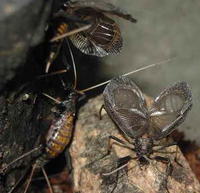
From a page full of Suzumushi Photos
http://nan2228.hp.infoseek.co.jp/suzumusi-nikki.htm
.....
kantan 邯鄲 snowy cricket
..... all green animal, starts in August to sing RURURUUU
Oecanthus longicauda
kigo for early autumn
lark of the weeds, kusahibari 草雲雀
grass cricket
asasuzu 朝鈴(あさすず)"morning bell"
kinhibari, kin hibari 金雲雀(きんひばり)
Paratrigonidium bifasciatum
kigo for early autumn
Fruit Cricket, Prayer Gong Cricket (kanetataki) 鉦叩
Ornebius kanetataki
kigo for early autumn
。。。。。。。。。。。。。。。。。。。。。。。。。。。。。。。。。
kigo for early autumn
long-horned grasshopper (Platyphyllum concavum,
some sources quote: Gampsocleis buergeri)
Insect of the order Orthoptera, family Tettigoniidae
kirigirisu キリギリス 螽斯
..... gisu ぎす
..... "weaver" hataori 機織
..... "chasing after horses" uma-oi 馬追, uma-oi mushi 馬追虫
oblong-winged katydid, kutsuwamushi くつわ虫
Amblycorypha oblongifolia
..... gachagacha がちゃがちゃ
..... suito すいと
When courting the male sounds like SUIII-TCHO スイーッチョ, the sound children used to make when chasing horses in the Edo period.
The sound was perceived as melancholic and full of sorrow.
きりきりすいたくななきそあきのよの
なかきおもひは われそまされる
kirigirisu itaku na naki so aki no yo no
nagaki omoi wa ware zo masareru
kirigirisu --
do not grieve so, chirping crickets
this long autumn night
my prolonged sorrows
are greater even than yours
Fujiwara no Tadafusa 藤原たゝふさ 忠房
Kokin Wakashu poetry collection 古今和歌集
. kutsuwamushi katyd - haiku .
In the days of Basho, kirigirisu meant today's "koorogi": a cricket, Grylloidea.
grashoppers
having a wedding party -
come on, come on !
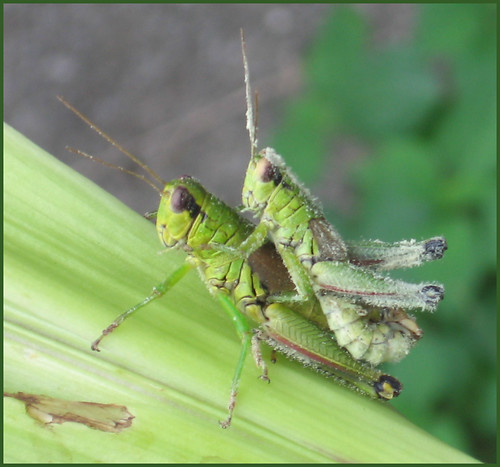
Gabi Greve, August 2008
CLICK here to read more about the mating habits of these animals and look at some photos which I managed to take ... !!
。。。。。。。。。。。。。。。。。。。。。。。。。。。。。。。。。
Some insects not so famous for their song
large, brown grasshopper/locust, batta ばった
Acrididae
..... hatahata 蟿螽 / 蹊蚸
..... keireki 螇蚚
kichikichi きちきち、batta ばった、batabata ばたばた
kichikihci batta きちきちばった
shooryoo batta 精霊ばった(しょうりょうばった)
inetsukimushi 稲舂虫 (いねつきむし)
kometsuki batta 秋 米搗ばった(こめつきばった)
kigo for all autumn
small green grasshopper/locust, イナゴ 蝗, 稲子,螽 inago
Oxya spp.
.... sometimes eaten
inagotori 蝗捕り(いなごとり)catching inago
inagogushi 蝗串(いなごぐし) stick with (fried) inago
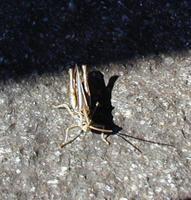
inagomushi 稲虫 (いなむし) "rice locust"
ine no mushi 稲の虫(いねのむし)
inagomaro 稲子麿(いなごまろ)
Oxya japonica. Reisschädling. Heuschrecke
mizokawa o obusatte tobu inago kana
mizuumi o chotto oyogishi inago kana
locust flies
riding on flowing
ditch water
locust after
a brief swim
in the lake
INAGO - Haiku by Issa and :
. comments by Chris Drake .
:::::::::::::::::::::::::::::::::::::::::::::::::::::::::::::::::::::::::::::::::::::::::::::::::::::
kigo for all autumn
itodo 竈馬 (いとど) cave cricket
..... kamauma かまどうま "horse of the hearth"
..... kamadomushi かまどむし"insect of the hearth"
okama koorogi おかま蟋蟀(おかまこおろぎ)"hearth cricket"
hadaka koorogi 裸蟋蟀(はだかこおろぎ)"naked cricket"
ebi koorogi えび蟋蟀(えびこおろぎ)"locust cricket"
osaru koorogi おさる蟋蟀(おさるこおろぎ)
This animal likes to live in the kitchen, especially of old farmhouses.
Atachycines apicalis, Diestrammena apicalis. Höhlenschrecke
. . . CLICK here for Photos !
:::::::::::::::::::::::::::::::::::::::::::::::::::::::::::::::::::::::::::::::::::::::::::::::::::::
kigo for early winter
fuyu no mushi 冬の虫 (ふゆのむし) insects in winter
mushi oyu 虫老ゆ(むしおゆ)insects getting old
mushi karuru 虫嗄るる(むしかるる)
insects singing with a hoarse voice
mushi tayuru 虫絶ゆる(むしたゆる) "voice is soon over"
After their great time in autumn, many insects still chirp, but their voices are getting more quiet, hoars and their song will soon be over. As a kigo, this brings a melancholic background to a haiku.
. locust in winter, fuyu no inago 冬の蝗 (ふゆのいなご)
grashopper in winter
:::::::::::::::::::::::::::::::::::::::::::::::::::::::::::::::::::::::::::::::::::::::::::::::::::::
:::::::::::::::::::::::::::::::::::::::::::::::::::::::::::::::::::::::::::::::::::::::::::::::::::::
Mushi no Koe : CHIRPS OF INSECTS
by Rie
After a hot and muggy Summer in Japan, Autumn begins in September. Many Japanese appreciate the Mid-autumn Full Moon, which is said to be the most beautiful full moon, and love to hear the chirps of crickets and grasshoppers. On a dark night in September, when I hear the fine song of insects in a garden, I feel Nature very close and intimate.
The chirps remind me of a song that we used to sing in a music lesson in my school, " Matsu-mushi began to chirp, chin-chiro chin-chiro, chin-chiro rin, ah Suzu-mushi began to chirp, rin-rin rin-rin riiin-rin". Matsu-mushi and Suzu-mushi are kinds of crickets, their names are familiar as singing insects in Japan. When I sang the song when I was seven or eight years old, I didn't know what they looked like, but I had a friendly feeling towards the chirps. When I was twelve years old, my grandmother was given Suzu-mushi by her friend and she enjoyed hearing the beautiful chirps every night in her room. I was in charge of taking care of them. While I replaced the old food (cucumber, egg plant or water melon), splayed misty water to make the soil wet, I watched the insects and the system of their chirps. Males only made a sound by rubbing thier wings to attract females.
Since the old days, people have loved to hear songs of insects and many traditional poets have composed poems about them. Even now, people can buy Suzu-mushi at a pet shop to hear their songs. I've heard that this custom is a peculiar to Oriental culture, what do you think ? I know the Aesop story titled "the grasshopper and the ants". In that story, the grasshopper plays music, so I think Western people consider chirps as music. Do you agree ?
(8th September 1996)
http://www.linkclub.or.jp/~kosa/rie/small/musi.html
:::::::::::::::::::::::::::::::::::::::::::::::::::::::::::::::::::::::::::::::::::::::::::::::::::::

Photo © by Carol Raisfeld
Read a moving haibun about this little fellow
by Carol Raisfeld
http://home.alc.co.jp/db/owa/ph_diary?stage=show&diary_sn_in=311
praying mantiss, kamakiri 螳螂 Tenodora aridifolia
..... tooroo, tōrō 螳螂
..... ibomushiri いぼむしり
a visitor's card
left at my doorstep ...
praying mantiss
Look at an amazing photo here !
© Gabi Greve, August 2007
:::::::::::::::::::::::::::::::::::::::::::::::::::::::::::::::::::::::::::::::::::::::::::::::::::

bagworm, basketworm, minomushi 蓑虫 larva of Psychidae
..... demon-child, oni no ko 鬼の子
autumn butterfly, aki no choo 秋の蝶
..... see photo below
:::::::::::::::::::::::::::::::::::::::::::::::::::::::::::::::::::::::::::::::::::::::::::::::::::::
『蟲のこゑ』(むしのこえ)は文部省唱歌
1932年
Official School Song from 1932.

あれ松蟲が鳴いてゐる。
ちんちろちんちろ ちんちろりん。
あれ鈴蟲も鳴き出した。
りんりんりんりん りいんりん。
あきの夜長を鳴き通す
あゝおもしろい蟲のこゑ。
きりきりきりきり きりぎりす。
がちやがちやがちやがちや くつわ蟲。
あとから馬おひおひついて
ちよんちよんちよんちよん すいつちよん。
秋の夜長を鳴き通す
あゝおもしろい蟲のこゑ。
© More in the WIKIPEDIA !
Aaa, here is the pine cricket's song
chin chirochin chirochin chirorin
Now listen, the bell cricket chimed in
ring ringring ring riingring
They sing all through the long autun night!
How interesting all these voices of insects!
Kirikiri kirikiri, the crickets
Gachagacha gachagacha, the oblong-winged katydid
And now chiming in the katydids
chonchon chonchon suit-chon
They sing all through the long autun night!
How interesting, all these voices of insects!
Tr. Gabi Greve
*****************************
Worldwide use
In many countries, other kinds of crickets are chirping and singing in other seasons.
Mostly in spring and summer they are already doing their part to bring joy to the listeners.
We will try and list some here.
CHINA
List of common singing and fighting crickets in China.
... ... ... Grylloidea
Anaxipha pallidula (Matsumura, 1911) "Xiao Huang Ling" small yellow bell
Anaxipha sp. n. "Da Huang Ling" large yellow bell
Homeoxipha lycoides (Walker, 1869) "Mo Ling" inky bell
Svistella bifasciatata (Shiraki, 1911) "Jin Ling Zi" golden bell
Dianemobius fascipes (Walker, 1869) "Ban Ling" spotted bell
Dianemobius flavoantennalis (Shiraki, 1911) "Hua Ling" flowered bell
Ornebius kanetataki (Matsumura, 1904) "Shi Ling" stony bell
Scleropterus punctatus (Brunner, 1893) "Pan Ling" rocky bell
Oecanthus longicaudus (Matsumura, 1911) "Zhu Ling" bamboo bell
Homoeogryllus japonica (De Haan, 1842) "Ma Ling" horse bell
Truljalia hibinonis (Matsumura, 1911) "Jin Zhong" golden bell
Truljalia forceps (Saussure, 1878) "Jin Zhong" golden bell
Xenogryllus marmoratus (De Haan, 1842) "Bao Ta Ling" pagoda bell
Turanogryllus eous (Bey-Bienko, 1956) "Qing Ling" blue bell
Gryllodes sigillatus (Walker, 1869) "Zhao Ji" stove cricket
Velarifictorus micado (Saussure, 1877) "Cu Zhi" fighting cricket
Velarifictorus aspersus (Walker, 1869) "Cu Zhi" fighting cricket
Gryllus bimaculatus (De Haan, 1773) "Hua Jing" painted mirror
Teleogryllus emma (Ohmachi & Matsumura, 1951) "You Hu Lu" oil guord
Loxoblemmus doenitzi (Stein, 1881) "Guan Cai Tou" coffin-headed
Loxoblemmus equestris (Saussure, 1877) "Guan Tou Xi" coffin-headed cricket
Tarbinskiellus portentosus (Lichtenstein, 1796) "Da Xi Shuai" giant cricket
The cricket has also served as a watchdog in China and other Asian countries for generations. At any sign of danger, the chirping will stop.
Look at some more:
http://www.insects.org/ced3/singing.html
:::::::::::::::::::::::::::::::::::::::::::::::::::::::::::::::::::::::::::::::::::::::::::::::::::::
Germany
Grillen zirpen.
Feldgrille, kigo Sommer
:::::::::::::::::::::::::::::::::::::::::::::::::::::::::::::::::::::::::::::::::::::::::::::::::::::
Europa
Field cricket, Gryllus campestris
kigo for summer
Feldgrille
. . . CLICK here for Photos !
Native to Europe, but quite an endangered species now.
They prefer dry, sunny locations with short vegetation. The males make a burrow with a platform at the entrance from which they attract females with their "song." They are often found from May to August when the males sit at the mouths of their burrows and sing day and night.
A lonely apple-tree,
a lonely field-cricket sings for
all neighbours.
Joze Volaric (Slovenia)
http://www.tempslibres.org/aozora/en/regpub/volaric1.html
"To find a cricket on the hearth
is the luckiest thing of all."
The Cricket on the Hearth - Charles Dickens
:::::::::::::::::::::::::::::::::::::::::::::::::::::::::::::::::::::::::::::::::::::::::::::::::::::
Kenya
topic for haiku
Crickets cannot be a kigo since they are there all year round. However, it greatly depends with the surroundings; for instance, they are not very much available in places where concrete buildings abound, but they are available at dusk in quiet natural places with trees and grass.
Patrik Wafula
basking on the lawn--
the chirping of the cricket
makes her gasp
Caleb
Kenya Saijiki Forum
:::::::::::::::::::::::::::::::::::::::::::::::::::::::::::::::::::::::::::::::::::::::::::::::::::::
North America
Field cricket, Gryllus campestris
kigo for summer
Here are some sound files.
Linda Papanicolaou
North American singing insects:
http://buzz.ifas.ufl.edu/
http://www.naturesongs.com/insects.html
http://freesound.iua.upf.edu/samplesViewSingle.php?id=1053
http://animaldiversity.ummz.umich.edu/site/accounts/sounds/Arthropoda.html
xxxxxxxxxxxxxxxxxxxxxxxxxxxxxxxxxx
Here's a link to our Kentucky-style Field Crickets.
Field Cricket - Scroll down for the sound link:
http://tinyurl.com/a8z2x
Kentucky Bluegrass (grass): http://tinyurl.com/9bzmu
'Bluegrass' is also a famous style of mountain/folk music...ENJOY these foot-tappin' music clips!:
http://www.rolandwhite.com/sounds.htm
chee chee chee
field crickets performin'
Kentucky Bluegrass
b'oki
:::::::::::::::::::::::::::::::::::::::::::::::::::::::::::::::::::::::::::::::::::::::::::::::::::::
Russia
We say about crickets that they "chirp" (стрекочут - strekochut: streh-koh-choot). We also say that they sing (поют - poyut: poh-yoot). If we want to say how they do it, we would probably choose the sound "цвирк-цвирк-цвирк" - tsvirk-tsvirk-tsvirk.
We say about flies and bees that they "жужжат" - "zhuzhzhat" -zhoozh-zhut (buzz). The sound "zh" is approximately the sound you hear in the middle of the words "pleasure" and "measure" (and thus my name does not start with the sound "z" :).
When we want to show the sound they make, we use "zh-zh-zh" - "ж-ж-ж"
Summer night-
the Earth speaks to the stars
in Cicada
(WHR, 2005 spring-summer)
Летняя ночь -
Земля говорит со звёздами
на языке цикад
********
office tension -
a fly at the window
keeps buzzing
(4th place in Shiki Double Kukai, January 2004)
натянутость в офисе -
муха на окне
продолжает жужжать
.....
"натянутая обстановка в офисе" ?
Критическим замечаниям по переводам буду рада.
Кто может ещё подсказать, какие звуки издают насекомые?
Zhanna P. Rader
:::::::::::::::::::::::::::::::::::::::::::::::::::::::::::::::::::::::::::::::::::::::::::::::::::::
Spain
cri cri cri cri cri all the time :)
acustic greetings from spain
Maitia
:::::::::::::::::::::::::::::::::::::::::::::::::::::::::::::::::::::::::::::::::::::::::::::::::::::
Yemen
The long-horned grasshopper alias [predatory] bush cricket alias katydid.
These insects are basic food for the [famous] yemeni veiled chameleon.
"all night long"
in mocha scent the old tune
katydid
Heike Gewi
(Yemen Saijiki)
*****************************
Things found on the way
Japanese Singing Insects
© Robert W. Pemberton, 1994
(for the illustrations see the link given below)
The Japanese have a long tradition of enjoying the calls of various Orthoptera, both in the wild and as caged pets (Lafcadio Hern, 1905, Exotics and Retrospectives, Little, Brown and Co., Boston). These customs have been popular with both the Japanese Court, which probably introduced some of the customs from China, and with the common people. Visiting places, known for the abundance and high quality of their singing insects, was one of the seasonal pleasures, such as cherry blossom and autumn leaf viewing. Although many of these customs have been lost or simplified with Japan's modernization, there remains a fondness for the "cries" of certain species of crickets (Gryllidae) and long-horned grasshoppers (Tettigonidae). The following illustrations and notes show various aspects of Japan's cricket culture.
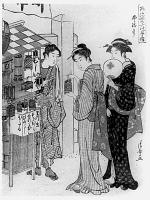
"The cricket cage peddlar", Kiyonaga, ca. late 1700s, (courtesy of The Art Institute of Chicago).
Cricket sellers were members of an organized guild recognized by the checkerboard motif used on the cloth of their stands and kimonos. These mobile merchants sold diverse and beautifully crafted cages, including ones that resembled fans, boats and country cottages, to house the singing insects. The singing insects of commerce were both reared and collected from the wild.
Cricket cage made of twigs, wire and the sheath of a bamboo shoot, ca. 1950 (courtesy of Kyushu-Tokai Univ.).
This wire mesh type of cage was used for smaller crickets. The finely crafted cages of the past are now rarely made; most modern cages are clear plastic terrariums with ventilated tops. These terrariums are sold to keep and rear a few species of singing Orthoptera (mainly the bell insect, Homoeogryllus japonicus de Haan), which are also sold along with specially packaged bell insect food and soil in pet shops.
A book "How to raise singing insects" written in 1983 by Kimio ONO and Hideaki OGASAWARA (New Science Co., Tokyo).
This book, which shows the bell insect (suzumushi) on its cover, contains natural history, rearing information and even poetry on five of the most favored cricket species and one katydid, and briefer sections on fourteen other crickets and katydids. Raising singing insects is a popular past-time. Singing crickets are given as gifts to customers by some produce markets and to the friends of some cricket hobbyists.
Electronic katydid in a paper covered plastic box cage, 1992, $9 US.
The plastic katydid and its electronic chip mimic a popular long-horned grasshopper (kirigirisu, Gampsocleis buergeri de Haan) in both appearance and sound. This cage also features flashing fireflies. Electronic bell insects, including one with a very accurate chip that was sold in a Tokyo Mitsukoshi Department store for $200 US in 1990, are also available. Recordings of singing Orthoptera are sold in record stores, and can be heard in subway stations and other public places
The original with illustrations is here
http://www.insects.org/ced3/japanese_sing.html
:::::::::::::::::::::::::::::::::::::::::::::::::::::::::::::::::::::::::::::::::::::::::::::::::::::

虫の音楽家 小泉八雲コレクション
- - - - - and
Mushi no bungaku 蟲の文学 Insect Literature
by Koizumi Yagumo (Lafcadio Hearn)

The Berlin-based author Yoko Tawada recently remarked that one of the difficulties she faced when translating Kafka’s short story “Metamorphosis” into Japanese was that the associations Japanese people had with insects — even presumably giant beetles — were different to those of Europeans. Tawada was alluding to the idea that Japanese appreciation of insects is one marker of Japanese cultural uniqueness.
http://matsuobasho-wkd.blogspot.jp/
source : Japan Times
:::::::::::::::::::::::::::::::::::::::::::::::::::::::::::::::::::::::::::::::::::::::::::::::::::::
A temple in Kyoto called "Bell Cricket Temple"
Suzumushidera 鈴虫寺 (華厳寺)
Famous for the sound of this insect in autumn.
http://www.suzutera.or.jp/
. Suzumushidera 鈴虫寺 .
and a Jizo wearing straw sandals
:::::::::::::::::::::::::::::::::::::::::::::::::::::::::::::::::::::::::::::::::::::::::::::::::::::

. san-shi no mushi 三尸の虫 .
The Three Worms in Taoism and Chinese Mecicine
:::::::::::::::::::::::::::::::::::::::::::::::::::::::::::::::::::::::::::::::::::::::::::::::::::::
Karma, Indra's Net and the Internet
grasshopper
your fool !
the tea is still hot
The details are here:
Gabi Greve, Japan, June 2004
If a butterfly flaps its wings in the Amazon jungle, we might end up with a taifun over here in Japan.
*****************************
HAIKU
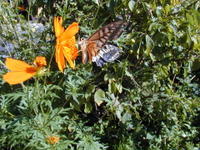
知恵もなし 無知恵もなし 虫の秋
無心に増さる 説法ぞなし
chie mo nashi
mu-chie mo nashi ya
mushi no aki
mushin ni masaru
seppoo zo nashi
..... .....
the wisdom
of NO-wisdom -
autumn of the insects
no-mind is best
no more preaching
..... .....
die Weisheit
der NICHT-Weisheit -
Herbst der Insekten
endlich frei von Gedanken
keine Predigten mehr
. ... .
Renku from Gabi Greve and Sakuo Nakamura
Wisdom 知恵と無知恵
xxxxxxxxxxxxxxxxxxxxxxxxxxxxx
独唱が合唱になり虫の秋
dokushoo ga gashoo ni nari mushi no aki
a solo
becomes a chorus -
autumn insects
(tr. Gabi Greve)
saiou
http://blog.goo.ne.jp/saiou01/e/03a28b35574232022bf8aed669ad2862
xxxxxxxxxxxxxxxxxxxxxxxxxxxxx
備長炭枕すがしき虫の秋
binchootan makura sugashiki mushi no aki
my pillow of charcoal
just so refreshing -
autumn of the insects
(tr. Gabi Greve)
葉子
http://www.kyoto.zaq.ne.jp/masuhiro/siritorishyuku.html
xxxxxxxxxxxxxxxxxxxxxxxxxxxxx
koorogi no kono ittetsu no kao o miyo
A cricket,
look at his face;
this headstrong face
(Tr. Nori Matsui)
Yamaguchi Syuson (1893-?)
http://www.haikuworld.org/dogwood/7/iv.html
xxxxxxxxxxxxxxxxxxxxxxxxxxxxx
koorogi ni/ nakarete bakari
Crickets are chirping,
Chirping to me all the time.
Tr. Copyright Takashi Nonin
Santoka (Santooka) 山頭火
http://haiku.cc.ehime-u.ac.jp/~shiki/shiki.archive/html/9512/0676.html
xxxxxxxxxxxxxxxxxxxxxxxxxxxxx
暁は宵よりさびし鉦叩
akatsuki wa yoi yori sabishi kanetataki
in morning light
it sounds even more lonely -
Kanetataki
星野立子 Hoshino Tatsuuko
現代俳句データベース
xxxxxxxxxxxxxxxxxxxxxxxxxxxxx
Die Grillen zirpen ihr Abendlied, -
wiegen die Gräser
in den Schlaf.
crickets sing their evening song -
swaying the grass
into sleep
Steffi Wittl
www.tmg.musin.de/haiku/jahreszeiten.htm
xxxxxxxxxxxxxxxxxxxxxxxxxxxxx
Die Grillen zirpen.
Der Himmel ist wolkenleer -
strahlend fließt das Licht.
crickets chirping
the sky without clouds
light flows shining
Laura Velte
www.tmg.musin.de/haiku/dichtung.htm
xxxxxxxxxxxxxxxxxxxxxxxxxxxxx
zwischen dem zirpen
das Gespräch der Zikaden
als trocknes Knacken
Klaus-Dieter Wirth
xxxxxxxxxxxxxxxxxxxxxxxxxxxxx
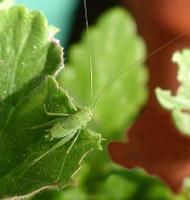
green on green -
eyes and antennae
search the air
Photo and Haiku © by Carol Raisfeld
http://home.alc.co.jp/db/owa/ph_diary?stage=show&diary_sn_in=246
:::::::::::::::::::::::::::::::::::::::::::::::::::::::::::::::::::::::::::::::::::::::::::::::::::::
Discussing the translation
Matsuo Basho at Shrine Tada Jinja
muzan ya na kabuto no shita no kirigirisu
so pitiful--
under the helmet,
a cricket
Tr. Barnhill
. Matsuo Basho 松尾芭蕉 - Archives of the WKD .
:::::::::::::::::::::::::::::::::::::::::::::::::::::::::::::::::::::::::::::::::::::::::::::::::::::
I listen
to the cricket ---
swinging door
- Shared by Myron Lysenko -
Haiku Culture Magazine, 2013
*****************************
Related words
***** . WKD : Voices of animals
***** Cicada (semi) Japan
Kigo for Late Summer
***** Autumn (aki) Japan
***** Dragonfly (tombo, tonbo) Japan
Kigo for All Autumn
***** Konchu Ryori, konchuu ryoori 昆虫料理 Insects as food in Japan
:::::::::::::::::::::::::::::::::::::::::::::::::::::::::::::::::::::::::::::::::::::::::::::::::::::
Photos on this page unless otherwise stated by Gabi Greve.
:::::::::::::::::::::::::::::::::::::::::::::::::::::::::::::::::::::::::::::::::::::::::::::::::::::
WASHOKU ... Japanese Food SAIJIKI
. ANIMALS in all SEASONS - SAIJIKI
:::::::::::::::::::::::::::::::::::::::::::::::::::::::::::::::::::::::::::::::::::::::::::::::::::::::::::::::::::::::::::
[ . BACK to DARUMA MUSEUM TOP . ]
[ . BACK to WORLDKIGO . TOP . ]
:::::::::::::::::::::::::::::::::::::::::::::::::::::::::::::::::::::::::::::::::::::::::::::::::::::::::::::::::::::::::::







22 comments:
虫売りの浮世絵はとても珍しく
楽しみました。
虫についてよい文章が集まりましたね
改めて、日本人の好みが判りました。
西洋人もこんなに虫が好きですか?
世界中の俳人に聞いてみたいと思います。
例えばイギリスースコットランドの民謡、庭の千草(アンニンローリー)などには
虫の音が出てきますね。
ドイツ人は如何ですか?
sakuo
in my closet
swallowing dreams -
a cricket
shane gilreath
sparrows' songs
in vast cicada drone ~
scent of jasmines
spring breeze ~
a grasshopper searches
rainbow labyrinths
Narayanan Raghunathan
::::::::::::::::::::::::::::::::::::::::::::::::::::::::::::::::::::::
. Insect symbolism, a detailed collection to read in the Kigo Library !!! .
::::::::::::::::::::::::::::::::::::::::::::::::::::::::::::::::::::::
don't cry, insects!
we're all headed
for the same exit
-Issa, 1817
(tr. David Lanoue)
http://cat.xula.edu/issa/
::::::::::::::::::::::::::::::::::::::::::::::::::::::::::::::::::::::
:::::::::::::::::::::::::::::::::::::::::::::::::::::::::::::::::::::
autumn insects -
and the noise of my neighbour
cutting weeds
Read more, by Gabi Greve, September 2006
.
chichiro-mushi/jotai no kioku/yomi-gaeru
cricket's song...
it stirs my memories of
the body of a woman
Sojo Hino (1901-56), by Susumu Takiguchi
::::::::::::::::::::::::::::::::::::::::::::::::::::::::::::::::::::::
.
making love
in the withered fields...
locusts
kare-gare no nobe ni koi suru inago kana
.枯々の野辺に恋するいなご哉
by Issa, 1810
Tr. David Lanoue, http://cat.xula.edu/issa/
.
Sometimes crickets sing
me awake through summer dreams—
sometimes, dear, you snore.
Michael R. Collings, USA
a piece of moss
crawls up the wall -
minomushi incognito
more about
minomushi, the bagworm as KIGO
Gabi
::::::::::::::::::::::::::::::::::::::::::::::::::::::::::::::::::::::
lonliness --
dangling from a nail,
a cricket
sabishisa ya / kugi ni kaketaru / kirigirisu
Matsuo Basho,
translated by David Landis Barnhill in "Basho's Haiku", 2004, State University of New York Press
- Kobayashi Issa -
mushi no hoka
ni mo nakigoto ya
yabu no ie
insects aren't
the only ones complaining --
house in the thicket
insects complain
even outside --
house in the thicket
This hokku was written in the 8th month (September) of 1822, when Issa was back in his hometown. It has nice enjambment, with the first line and second line connected without any break or pause. This kind of enjambment can sometimes be found in waka as well as renku. Issa may be using it to stress "even" (ni mo) at the beginning of the second line and to draw attention to two senses of naki- in the second line: 1) to cry or cry out and 2) to complain or grumble. Crying is what insects always do, though their cries sound lonelier and more soulful in the fall. They seem to be seeking shelter in the house and under its eaves, and there are so many now that the humans are beginning to cry out and complain, too.
The first line may also be read "mushi no soto..." The character 外 means both "in addition to" (hoka) and "outside" (soto). If read as "outside," then there are ironically even more crying insects inside the house than outside in the thicket, and the second translation would be better. Perhaps Issa liked this ambiguity and the oscillation between the two readings it sets up.
Chris Drake
David Lanoue also translates this haiku:
mushi no soto ni mo nakigoto ya yabu no ie
the insects outside
are grumbling too...
house in the trees
Issa, tr. Lanoue
I think 'grumbling' is a 'grrrreat' word here, very insect sound-suggestive!
Lanoue also translates a similar Issa haiku from 1825:
nakigoto ya mushi no soto ni wa yabu no ie
grumbling--
the insects outside
the house in the trees
Issa, tr. Lanoue
Lanoue points out that:
"The original poem has an irregular syllable structure of 7-5-5. The rewrite is 5-7-5."
Is this perhaps why Issa wrote a more 'standardized' version?
For me, "house in the thicket" sets a different scene than "house in the trees." I associate "thicket" with "bamboo thicket," which makes me see a relatively claustrophobic setting for the house. "House in the trees" is more suggestive to me of a house perhaps in or near an orchard, or in a forest glade.
Larry Bole
Kobayashi Issa -
by Chris Drake
the eaves
stamped on, destroyed
by autumn insects!
koorogi ni fumitsubusareshi hisashi kana
This hokku appears in the manuscript that contains Issa's hokku for 1811, when Issa was 49, along with some renku and haibun passages. A later, unknown editor named it Waga haru-shuu (My Year's Collection). The preface is signed, "Issa, Boss of the Beggars of Shinano." The verse regarded alone is a bit mysterious, but the context provided by this collection of hokku and haibun provides some hints that aid interpretation, so I will discuss this context below.
Issa doesn't say whose house this is, but the context suggests it is the run-down house of a very poor farming family, probably near Edo. The thatched eaves of the deteriorating roof are crumbling and no longer protect the porch or the floor inside from rain or dew.
Using hyperbole, Issa says the tiny legs of the gradually weakening autumn insects have trampled on the eaves and destroyed them, an image so exaggerated that ir seems to be ironic. In modern Japanese, koorogi means 'cricket,' but in Issa's time it was a general term for all the autumn insects, but they are all equally light and weak. Why such extreme hyperbole? In my reading, Issa is using both irony and social realism to talk about the opposite of the small, light insects. Although it would be dangerous for Issa to express this thought directly, he seems to me to be suggesting that it is the samurai class and the highly exploitative policies of that class, headed by the shogunate in Edo, that is causing the roofs -- and the lives -- of so many impoverished farmers to collapse.
I believe this ironic reading is supported by the hokku and haibun surrounding this hokku. As in Oraga haru (My Year) and other haibun and hokku collections by Issa, individual hokku are often parts of larger image flows that influence how individual hokku are read.
Here is the apparent seven-hokku sequence, beginning with the two hokku at the end of a haibun section. The hokku about the insects and the eaves is the fifth in the series. The hokku translated here are in the order Issa gives in My Year's Collection, and below the hokku I discuss each one individually:
even the moon
gets quite an earful --
cool evening
green rice
trampled on the ground
still trying to ripen
old scarecrows
three or four, they too
by the Sumida River
the deer hesitate
do not step on
the bush clover
the eaves
stamped on, destroyed
by autumn insects!
I see dew inside
but this is a house
people live in
autumn wind
blowing the same way
as Issa's mind
.
Chris Drake
.
Yosa Buson
虫売のかごとがましき 朝寝哉
mushi uri no kagotogamashiki asane kana
The insect seller
Pretends it's summer, or so it seems, and
Sleeps in this morning.
Tr. Thomas McAuley
Sleeping late in the morning. . .
Matsuo Basho - cave cricket
海士の屋は小海老にまじるいとど哉
ama no ya wa ko-ebi ni majiru itodo kana
MORE
about woman divers
Kobayashi Issa
こおろぎが顔こそぐって通りけり
koorogi ga kao kosogutte toori keri
a chirping insect
tickles my face
and moves on
This hokku was written in the 9th month (October) of 1825, when Issa was traveling around near his hometown. The autumn insect that walks over or brushes by Issa's face isn't specified, perhaps because Issa is evoking the realm of touch. In Issa's era, the word koorogi was a general term for all autumn insects that made chirping or singing sounds. After westernization took place, the meaning of koorogi narrowed to a single kind of insect: crickets. In Issa's time, however, crickets were called kirigirisu. To make things even more topsy-turvy, the meaning of kirigirisu changed in the modern period from cricket to katydid or grasshopper.
This hokku is another example of the way Issa likes to experience and represent the world through the sense of touch. It would probably be an exaggeration to say Issa took pleasure in this experience, but he may well have enjoyed the chance to momentarily feel and communicate with another creature directly, with his skin.
Chris Drake
.
kago 籠 / 篭 / かご basket, baskets of all kinds
/
Cricket haiku from Kenya
old hut --
a cricket hidden
in a crack
~ Beatrice Syombua
only the sound
of two mating crickets --
quiet evening
~ Denis shakava
sleepless night --
the chirp of a lone cricket
keeps me company
~ Arnold Ichenje
morning drizzle --
a lone cricket chirping
in star grass
~ mwugusi collins
fading sunset --
the chirps of our crickets
grow louder
~ Patrick Wafula
silent evening --
crickets singing
in the bush
~ Edmond Tito
glowing sunset --
shrill chirps of crickets
refresh my mind
~ Peter Kimuli
melodious crickets
and my mum's humming --
supper preparations
~ mercy mbithe
I stealthily trail
a cricket on the wall --
full concentration
~ john ngota
I dance
to the crickets' chirps --
feet making beats
~ oscar ochieng
https://groups.yahoo.com/neo/groups/kenyasaijiki/conversations/messages/5758
.
こほろぎや青物市のこぼれ菜に
koorogi ya aomono ichi no koboreha ni
this cricket -
it sits on a fallen leaf
at the vegetable market
. Masaoka Shiki 正岡子規 .
.
more about aomono vegetables in Edo
http://edoflourishing.blogspot.jp/2015/12/aomonocho-district.html
.
Kobayashi Issa
.
きりぎりす鳴やつづいて赤子なく
kirigirisu naku ya tsuzuite akago naku
a long-horned grashopper
cries - and then
a baby cries
.
the cut marker YA is in the middle of line 2.
.
The word NAKU can be used for the sound of an animal and the crying of humans.
.
Post a Comment